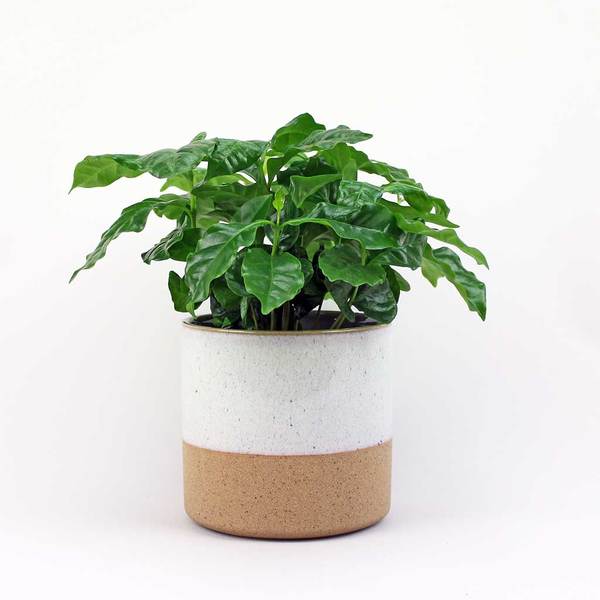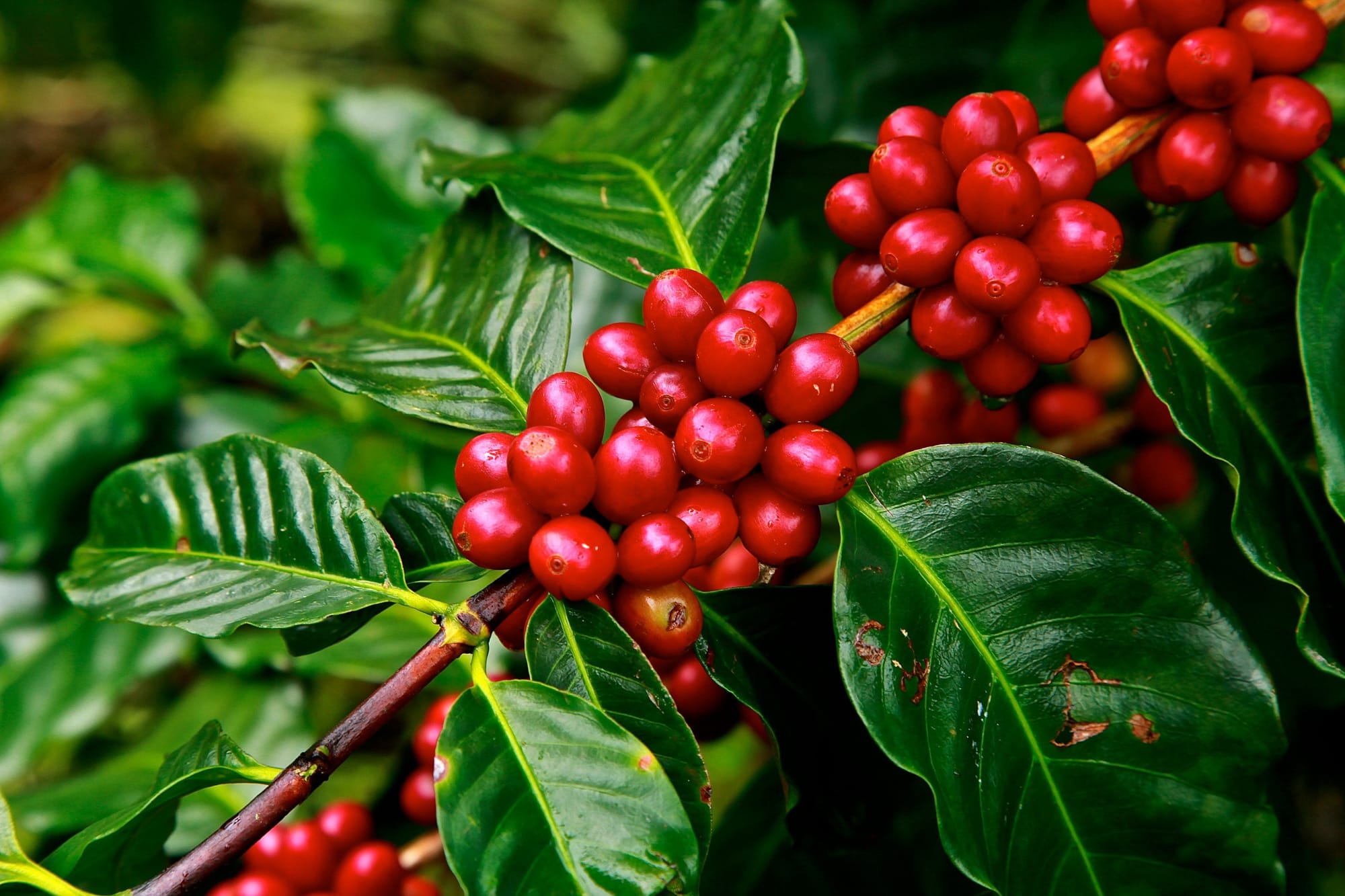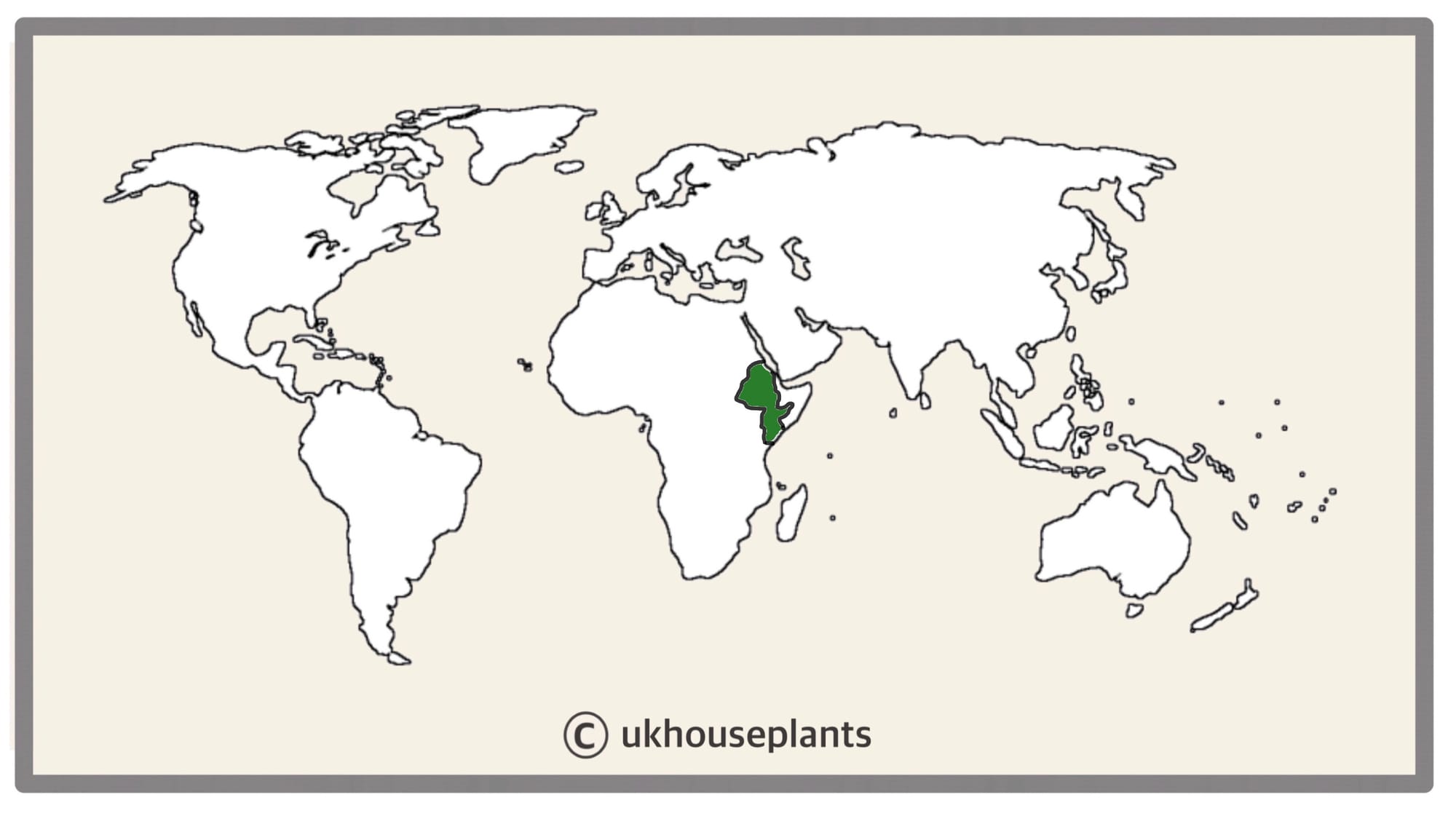
Coffea arabica - Copyright: BloomBox Club
Contents
- Top Tips
- Location, Water, Humidity & Fertilisation
- Common Issues
- Origins, Temperature, Propagation, Repotting & Toxicity.
Need the answer to a specific plant query? Book a 1-to-1 video call with Joe Bagley, the website's friendly author, to overcome and address your niggling problem! Available on iMessage, WhatsApp, Facebook Messenger & more.
Top Tips & Info
- Care Difficulty - Moderate
- Coffee Plants like a bright, indirect location away from the harsh sunlight throughout the day's peak hours. You can get away with keeping it in a windowsill that offers no more than two hours of morning sunlight, but always be wary of drying soil and sun-scorch.
- They'll require near-constant moist compost, with the soil's top third drying out in between waters. Avoid over-watering as the risk of root rot and stem collapse is relatively high, especially during the winter period. Under-watering, however, is less common but can still cause severe consequences to the specimen's overall health.
- Introduce a pebble tray to keep the local atmosphere humid throughout the year.
- Fertilise using a 'Houseplant' labelled feed every four waters in the spring and summer, reducing this to every six in the colder months.
- Repot every two years during the spring with a 'Houseplant'-labelled potting mix and the next sized pot. Treat the roots with respect as Transplant Shock is a prominent killer among newly-planted specimens.
- Keep an eye out for Spider Mites & Mealybugs that'll hide in the plant's cubbyholes and under-leaves.
Location & Light - 🔸🔸🔸
Coffee Plants require an area that offers not only bright, indirect light, but also a relatively warm site, too. This species' natural habitat is in the Ethiopian hills, meaning that temperatures will rarely dip below 18℃ (64℉). Although you shouldn't provide excessive sun, a location that offers no more than two hours of morning or evening sunlight is perfect for good, quality growth - but always remember to maintain evenly moist soil. A bright, indirect location is also perfectly acceptable for this species.
Water - 🔸🔸🔸
Coffee Plants are best kept in reliably moist soil, as inconsistent moisture levels may result in stunted growth and an unhappy plant. Allow the compost's top third to dry out in between waters in the growing period, reducing this further in the autumn and winter. Due to the sensitivity of their root systems, never apply cold water as it may weaken its health and overall well-being. For those that use tap water (instead of rainwater or fresh bottled water), allow it to stand for at least 24hrs to eliminate the high levels of chloride and fluoride found from the tap. Under-watering symptoms include a shrivelled stem, yellowing leaves, a browning halo on the leaf, little to no growth and dry, crispy patches forming on the leaf edges. These issues are usually caused by too much light/heat or forgetfulness. Remember, the brighter the location, the more watering you'll need to do. Keep an eye out for sun-scorch which will be a byproduct of dehydration, too. Over-watering symptoms include a weakened or rotten stem, no new growth, yellowing lower leaves and eventual plant death. Click here to learn more about root rot and how to address it.
Humidity - 🔸🔸🔸
Create a humidity tray to provide a moist and stable environment for your plant. If the surrounding saturation is too low or the heat too high, its leaf-tips may start to brown over and curl, especially in direct sunlight. Gently hose the foliage down from time to time to hydrate the leaves and keep the dust levels down, too.
Fertilisation - 🔸🔸
Fertilise every four waters during the growing period before reducing this to every six in the autumn & winter. Although an 'All-Purpose' fertiliser will still do the job, we'd recommend using a specific 'Houseplant' labelled fertiliser as it'll support the vital thirteen nutrients that this species will need to grow.
 The fleshy red berries of a wild Coffee plant, shortly after successful pollination. Copyright: Sustainability Times
The fleshy red berries of a wild Coffee plant, shortly after successful pollination. Copyright: Sustainability Times
Common Issues with Coffee Plants
If you still can't find the answer to your specific houseplant problem, book a 1-to-1 video call with Joe Bagley to point you in the right direction today.
Curled leaves and brown leaf-edges are the result of too little water and over-exposure to the sun. Coffee Plants are best located in bright settings, with those that haven't acclimatised to the harsh rays may show signs of sun-scorch and environmental shock. A splash of morning sunlight is acceptable as long as the soil moisture is regularly observed, once the introductory period has elapsed.
Too low humidity can cause browning tips with yellow halos on juvenile leaves. Although this won't kill your specimen, you may want to increase the local moisture to prevent the new growth from adopting these symptoms. Mist or rinse the foliage from time to time and create a humidity tray while the heaters are active to create a stable environment. Browning leaf tips are an inevitable part of a leaf's maturity though, so never be too disheartened if your specimen is showing signs of this!
If your specimen is located in a dark environment with mould developing on the compost's top layer, use a chopstick to stab the soil in various areas gently. Aim to enter the compost between the base of the plant and the pot's edge, as failure to do so may lead to damaging its lower portion. Leave the holes open for a few days before re-surfacing the soil to avoid it becoming overly dry. Not only will the gentle shift in the soil's structure mimic the work of small invertebrates in the wild (worms, etc.), but it'll also add oxygen back into the soil, thus reducing the risk of root rot. Repeat this monthly, or whenever you feel the potting-mix isn't drying out quickly enough.
Spider Mites are small, near-transparent critters, that'll slowly extract the chlorophyll from of its leaves. Have a check under the leaves, most notably along the midrib, for small webs and gritty yellow bumps. Click here to read our article about the eradicating Spider Mites, along with some extra tips that you may not find elsewhere!
Yellowing lower leaves could be a sign of irrigation abuse, but equally is a byproduct of maturity. If the older leaves rapidly become yellow in quick succession, both under, or over-watering could be to blame. People don't realise that a plant's root system needs access to oxygen too; when soil is watered, the air will travel upwards and out of the potting mix. A lack of accessible oxygen for the roots will cause them to subsequently breakdown over the oncoming days. If yours is a victim of neglect, create a watering schedule to avoid forgetfulness in the future.
Never allow temperatures to dip below 15ºC (59ºF) as irreversible damage may occur in the likes of blackened foliage and weakened growth. If this happens, remove the severely affected areas and immediately improve growing conditions - never cut through the weakened growth. As rehabilitation can take several months because of its slow-growing nature, be sure to provide a stable location with better growing conditions to speed this process.
Origins
Coffea arabica was first formally classified by Antoine de Jussieu as 'Jasminum arabicum', before being replaced by Carl Linnaeus in 1737 into its current genus. The word, coffee, has Arabic heritage that can be translated to 'dark' or 'sour', dating back to the early 16th-century practice of coffee production in Yemen. Arabica, or Arabicum, comes from Modern Latin to describe the very Arabian Peninsula.
 The Distribution of Coffea arabica.
The Distribution of Coffea arabica.
Temperature
15° - 32℃ (59° - 90℉)
H1a (Hardiness Zone 13) - Must be grown indoors or under glass all year round. Never allow temperatures to dip below 15℃ (59℉) or permanent damage may occur in the likes of flower loss, stunted growth and blackened or yellowed leaves.
Spread
In a domestic setting, the overall size can be up to 0.8m (3ft) in height and 0.5m (2ft) in width. The ultimate size will take between 8 - 10 years to achieve when repotted biannually, with around 5cm of growth per annum. Specimens in the wild can reach heights of over 3m (10ft).
Pruning & Maintenance
Remove yellow or dying leaves, and plant debris to encourage better-growing conditions. While pruning, always use clean scissors or shears to reduce the chance of bacterial and fungal diseases. Never cut through yellowed tissue as this may cause further damage in the likes of diseases or bacterial infections. Remember to make clean incisions as too-damaged wounds may shock the plant, causing weakened growth and a decline in health.
Propagation
Via Seed or Stem Cuttings.
Stem Cuttings (Moderate) - This method is an easy way to duplicate the original plant. Stems that are at least 8cm (3 inches) in height and part of an established plant are most successful. To avoid making a mess of the serrations, use a clean pair of scissors and cut 8cm down from the stem's end, dipping the wound in water and then into rooting hormone to speed the propagation. Rooting can take in the range of between two to eight weeks, depending on environmental factors and the cutting's quality. We recommend using a 'Houseplant' labelled potting mix, with a pot that has adequate drainage to avert the risk of blackleg. Provide a bright, warm setting of around 18℃ (64℉) with relatively moist soil, but be sure to allow the top half to dry out in between waters. You'll know if propagation is successful as the leaves will stay green and firm, along with small roots developing from the callous (dried wound). New foliar growth will emerge from the nodes after around twelve weeks, but it may take longer if the conditions aren't optimal. After a month of solid new foliar growth, transplant into a slightly bigger pot and treat it like a mature specimen with the care tips provided above.
Flowers
Coffee Plants will rarely flower in their lifetimes when domestically grown; however, for the interest of this section, their inflorescence is mostly white with thin, wispy petals that are put out in the early summer, lasting several weeks.
Repotting
Repot every two years in the spring, using a 'Houseplant' labelled potting mix and the next sized pot with adequate drainage. Coffee Plants are far better potbound for several years due to the heightened risk of root rot and repotting-issues (like transplant shock) - so only repot if you feel it's wholly necessary.
Hydrate the plant 24hrs before tinkering with the roots to prevent the risk of transplant shock. For those situated in a darker location, introduce extra amounts of perlite and grit into the lower portion of the new soil to downplay over-watering risks. Click here for a detailed step-by-step guide on transplantation, or via this link to learn about repotting with root rot.
Book a 1-to-1 video call with Joe Bagley if you'd like a personal guide to repotting your houseplant. This will include recommending the right branded-compost and pot size, followed by a live video call whilst you transplant the specimen for step-by-step guidance and answer any further questions!
Pests & Diseases
Keep an eye out for mealybugs, aphids, spider mites, thrips & whitefly. Common diseases associated with this species are root rot, red leaf-spot, heart rot, botrytis & southern blight - click here to learn more about these issues.
Toxicity
This plant is classified as poisonous; if parts of the plants are eaten, vomiting, nausea and a loss of appetite could occur. Consumption of large quantities must be dealt with quickly; acquire medical assistance for further information.
Retail Locations
IKEA & Online Stores.
Book a 1-to-1 Call with Joe Bagley
If you need further advice with your houseplants, book an advice call with ukhouseplants' friendly and expert writer today! This can be done via a video or audio call on most apps, including Facebook, FaceTime & Skype. A ten-minute call costs £5.99 (US$7), or £15.99 for thirty minutes. You can ask multiple questions, including queries on plants, pests, terrariums, repotting advice and anything in between. Please consider supporting this service to keep ukhouseplants thriving!